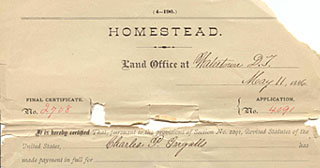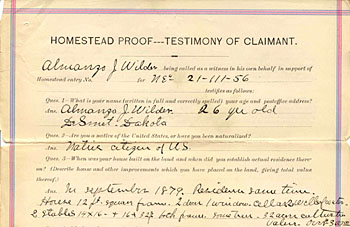Winter 2003, Vol. 35, No. 4
Genealogy Notes:
De Smet, Dakota Territory, Little Town in the National Archives
By Constance Potter

Portion of Charles Ingalls's final certificate for his homestead. (Records of the Bureau of Land Management, RG 49)
Knowing where people lived and understanding that community is as important as knowing when someone was born or died. Laura Ingalls Wilder, born in Wisconsin in 1867, wrote eight books about her childhood that describe how her pioneer family lived and traveled from Wisconsin to Indian Territory (Kansas) to Minnesota and finally in 1879 to Dakota Territory.
Wilder's "Little House" books document the story of her family and the pioneer communities where they lived. The last four books take place in De Smet, Dakota Territory (later South Dakota).
Much has been written about Wilder's books and whether her stories accurately reflect what happened. Wilder did not claim to be writing history but rather a story of her life as a little girl and young woman on the frontier. Through federal records, some incidents can be verified, and others can be reinterpreted.
To use the records of the National Archives, you need to know how a person or community could have interacted with the federal government. The federal government distributes public land, prepares annual reports, studies the weather, and opens post offices. (NARA does not, however, keep vital statistics - birth, marriage, and death records.) Using homestead files, annual reports, climatological reports, and post offices records, you can get a broader understanding of the time and place in which a person lived. An examination of the Ingalls and Wilder families in De Smet, shows how these records may be used to fill out a family or community history.
Laura's father, Charles Philip Ingalls, moved his family to Dakota Territory in 1879, when he took a job as storekeeper, bookkeeper, and timekeeper for the Chicago and North Western Railroad. Charles was born in Allegheny County, New York, in 1836, and his wife, Caroline Quiner Ingalls, was born in 1839 in Wisconsin. They married on February 1, 1860. The Ingalls had four daughters: Mary and Laura (both born in Wisconsin), Carrie (born in Indian Territory, later Kansas), and Grace (born in Iowa).
On August 25, 1885, Laura Ingalls married Almanzo James Wilder. Born in New York in 1857, Almanzo moved with his older brother, Royal, and sister, Eliza Jane, to Dakota Territory in 1879. All three homesteaded, and Eliza Jane taught school. Laura Ingalls Wilder described Almanzo's boyhood in Farmer Boy.
HomesteadingCharles Ingalls and the Wilders all filed for homesteads near De Smet. Under the Homestead Act of 1862 (12 Stat. 392), citizens and those who had filed their intention to become citizens were given 160 acres of land in the public domain if they fulfilled certain conditions. In general, an applicant had to build a home on the land, cultivate the land, and reside there for five years.
The National Archives holds the homestead files, which comprise the applications, proofs, and final certificates. To locate individual land records, you need to know the legal description of the land and the state office at the time of the transaction. (State offices can change.) This information is available from the clerk of the county court where the land is located or the Bureau of Land Management web site.
The amount of detailed information in case files varies from file to file. While Charles P. Ingalls's file contains only the basic details, Eliza Wilder's file includes two letters written in 1886 that detail her experiences as a homesteader.
Charles Philip IngallsCharles Ingalls filed for his homestead at the Land Office in Brookings, Dakota Territory, on February 19, 1880 (Sec. 3, Township 110 N, Range 56 W, Kingsbury Co., D.T.). In his testimony of claimant, Ingalls swore "I am the head of a family consisting of a wife and four children and a citizen of the United States." The names of his wife and daughters are not listed.
On April 30, 1886, the Kingsbury County News published Charles P. Ingalls's notice of intention to make final proof in support of his claims. Among his witnesses was Royal Wilder, Almanzo's older brother.
In his testimony of claimant filed in May 1886, Ingalls testified that by May 1880 he had built a 16' x 24' frame barn that dwarfed the original 14' x 20' house. Ingalls had added a one-story 12' x 16' addition. Apple and plumb trees provided food and shade. He estimated the homestead's total value at $1,000. Ingalls further testified that he had never made another homestead entry and that he was a "native born citizen."
Almanzo James WilderAlmanzo Wilder came to De Smet to homestead along with his older brother, Royal, and sister, Eliza Jane. In The Long Winter, Laura writes, "When he came West, Almanzo was nineteen years old. But that was a secret because he had taken a homestead claim, and according to law a man must be twenty-one to do that." (p. 99)
In his homestead proof dated September 12, 1884, Almanzo declared that he was twenty-six. On the same date, O. C. Sheldon, who had known Wilder for five years, certified that Almanzo was "over 21 years old." This is consistent with his entry on the 1880 census, where he is listed as twenty-two years old. Almanzo came to Dakota Territory to homestead, and there are no inconsistencies about his age in any of the public records found in the National Archives.

Top portion of Almanzo Wilder's homestead proof. (Records of the Bureau of Land Management, RG 49)
In Becoming Laura Ingalls Wilder: The Woman Behind the Legend (p. 64), John C. Miller writes that Laura changed her husband's age to minimize the ten-year difference in their ages. Miller also notes that Laura also reduced the age "to create the artificial drama of having him too young under the law to take out a homestead claim."
In 1884, Almanzo lived in 12' x 12' frame house with two doors, one window, and a cellar, while his stock lived in two stables, one 14' x 16', and the other 16' x 32'. That same year, Almanzo filed notice of his intention to make final proof in support of his claim (Sec. 21, Township 111 N, Range 56W, Kingsbury Co., D.T.). A. J. Sheldon, O. C. Sheldon, R. A. Boast, and C. P. Ingalls witnessed his intention.
De Smet, Dakota Territory, Little Town in the National Archives, Part 2
Constance Potter is a reference archivist specializing in federal records of genealogical interest held at the National Archives and Records Administration.